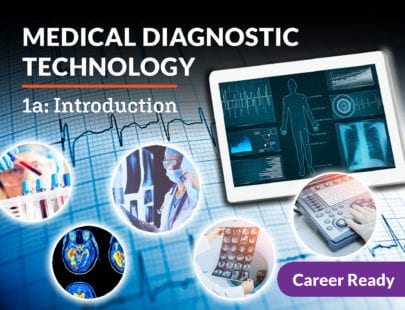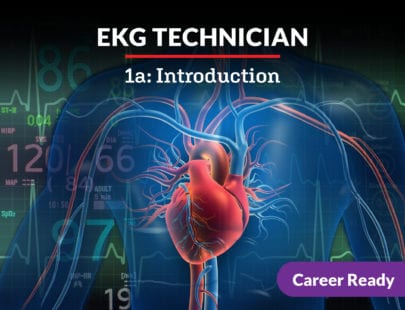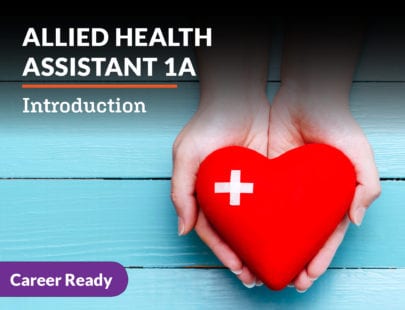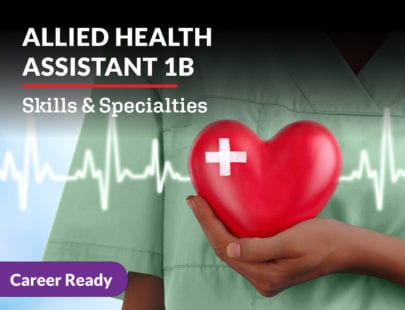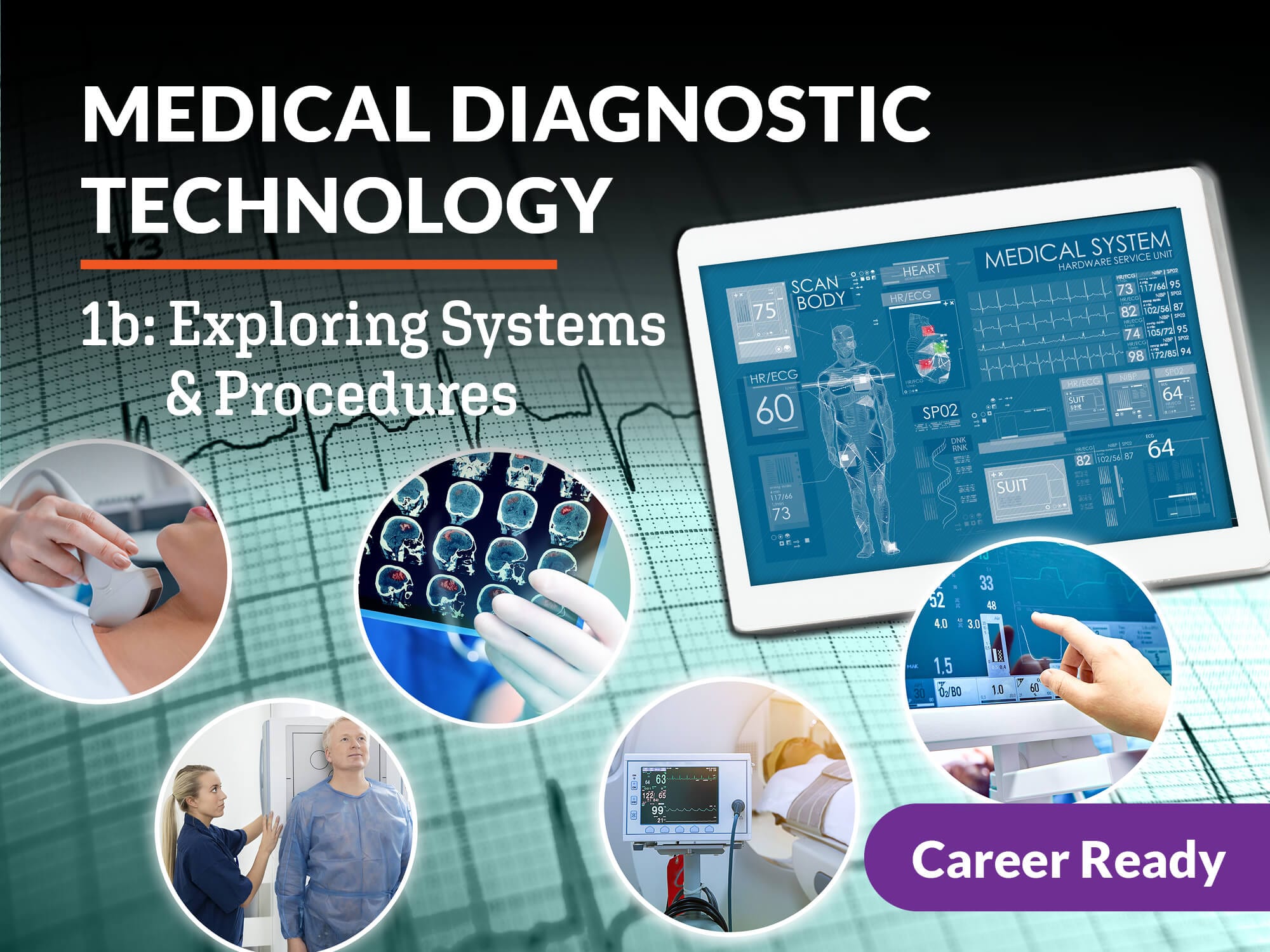
Medical Diagnostic Technology 1b: Exploring Systems & Procedures
Our bodies are complex, and when we start feeling ill, a doctor or specialist must analyze and diagnose what could be wrong. Learn about different diagnostic technology, procedures, essential body systems, and fluids that need to be understood to make an accurate diagnosis of a disease, condition, or illness. This career field is flourishing, and now is the time to be part of it!
Units at a Glance
Unit 1: How an X-Ray Works
When we think of a patient getting an X-ray, we think of the technologist taking the patient into a room and taking a picture. But there’s so much more to it than that! We’ll explore how X-rays are produced in the tube, how they interact with the patient’s body part to form an invisible image, how that image is processed, and the importance of image quality for diagnosis. We’ll also investigate how technological advances changed this world by creating a digital process. Let’s discover how an X-ray really works!
What will you learn in this unit?
- Describe the parts of the X-ray tube
- Explain how X-rays are produced, their properties, and how they interact with the body
- Identify factors that influence image quality
- Investigate the role of digital radiography in PACS and telemedicine
- Differentiate between screen film, computed, and direct radiography systems
Unit 2: Investigating the Lungs
We breathe constantly without thinking much about it, but any issues with this process can cause major issues with the body! How does the body maintain this remarkable, ongoing process? How is a diagnosis made if something goes wrong? For this part of our journey, we’ll look at the structures of the lungs, their function, the tools that measure this function, and the role medical diagnostic technology plays in identifying lung conditions. It’s time for us to check out the lungs!
What will you learn in this unit?
- Describe the parts of the respiratory and cardiopulmonary systems and their functions
- Use the medical terminology of the cardiopulmonary system to define words related to this system
- Identify methods of assessing respiratory patients, including normal and abnormal results
- Describe the tools and tests used to evaluate and diagnose lung conditions and diseases
- Explain the difference between restrictive and obstructive lung disease, and give examples of each type
Unit 3: Investigating the Heart
If you exercise or walk up a flight of stairs, you probably feel your heart pumping. You may even hear it! But the heart works all day every day and most of the time, we don’t even notice! How does an organ that’s so important to the body work? What happens when things go wrong? We’re going to analyze the structure and function of the cardiovascular system as well as cardiac conduction and circulatory pathways to help answer these questions. We’ll also identify tools and procedures used to verify conditions that impact this system. And what actions can we take when these conditions cause an emergency situation? We’ll also look at the healthcare professionals who help diagnose and treat patients with these conditions. It’s time to investigate the heart!
What will you learn in this unit?
- Describe the structure and function of the parts of the cardiovascular system
- Discuss circulatory pathways and the electrical conduction pathway of the heart
- Recognize the signs and symptoms of cardiopulmonary compromise and identify the appropriate response
- Name tests and procedures used to diagnose and treat cardiovascular conditions
- Explain careers, including educational requirements, certification, and licensure, involving the cardiovascular system
Unit 4: Keep It Beating! EKGs and Cardiac Monitoring Tools
As we know, there’s so much more to a heartbeat! Using cardiac monitoring tools like EKGs help us assess and diagnose cardiovascular conditions. As we delve into these tools, we’ll see how to set them up, care for patients during these tests, adjust for patient conditions, analyze the results, and troubleshoot if something isn’t working correctly. We’ll also cover the signs and symptoms of emergencies during these tests and how to respond to them. With this knowledge, we’ll help keep the heart beating like a drum!
What will you learn in this unit?
- Explain how the heart’s electrical conduction pathway corresponds to the waveform produced on an electrocardiogram
- Identify how to set up for an electrocardiogram, including electrode placement, infection control measures, maintenance of equipment, and troubleshooting
- Describe the types of tests that use electrocardiograms
- Analyze ways to adapt to changes in patient conditions in relation to the performance and interpretation of an electrocardiogram
- Differentiate between normal rhythms and arrhythmias as well as respond appropriately to life-threatening arrhythmias
Unit 5: Take a Deeper Look: Special Diagnostic Studies
What protects us from the elements? How do we regulate body temperature? What happens to humans if reproductive ability stops? The body has many specialized systems that perform often-overlooked but extremely important functions like these. We’ll explore these systems and investigate the medical diagnostic technology used to diagnose and treat conditions related to these systems. Let’s take a deeper look at special diagnostic studies!
What will you learn in this unit?
- Identify the structures and functions of tissues, membranes, and glands
- Describe the tools and tests used to diagnose conditions related to tissues, membranes, and glands
- Discuss the structures and functions of the reproductive system and tests used to diagnose related conditions
- Explain other special tests used to diagnose patient conditions such as sleep disorders, allergies, and psychological concerns
Unit 6: Other Diagnostic Imaging Modalities
How do physicians decide what type of imaging study to order? Is one kind better than another? As we investigate various diagnostic imaging modalities, we’ll analyze the differences between them as well as their advantages and disadvantages to find answers to these and other questions. We’ll use the muscular and endocrine systems as examples of how completely different systems require unique tests to arrive at diagnoses. It’s time to break down other diagnostic imaging modalities in a quest to find what’s best!
What will you learn in this unit?
- Identify and explain the functions of muscular system structures
- Discuss conditions related to the muscular system and some tests used to diagnose them
- Name and provide details on the functions of endocrine system structures
- Describe conditions related to the endocrine system and some tests used to diagnose them
Unit 7: Dye It! Contrast Studies as Diagnostic Tools
How can we see the details of the tissues and organs inside the body? Even with diagnostic imaging modalities, some body structures aren’t as clear or as detailed as we need them to be to get an accurate diagnosis. That’s where contrast plays a role! The many types of contrast allow healthcare providers to take a closer look at structures deep inside the body. As we explore the world of contrast, we’ll see how these dyes allow us to visualize a wide range of structures, leading to more accuracy in diagnosis!
What will you learn in this unit?
- Identify and describe the structures and functions of the parts of the gastrointestinal system
- Describe conditions of the gastrointestinal system
- Describe types of contrast media and the potential complications of using each type
- Explain multiple procedures that use contrast media to aid in diagnosis
- Recognize additional steps needed in the patient care process when using contrast media
Unit 8: Looking Into the Future: Diagnostic Technologies
With so many options in medical diagnostics technology already, where is the future of diagnosis and treatment headed? We’ll take a look at where it all began and delve into the newest technologies being developed and used today. We’ll also examine some barriers to using new technologies and how the healthcare industry responds to them. Get your time machine ready because we’re going to be looking into the future of developing medical diagnostic technology!
What will you learn in this unit?
- Provide brief histories of radiology, medical laboratory, EKG, and pulmonary function testing
- Discuss how electronic health records and patient portals impact healthcare systems
- Explain how telemedicine is changing the care process as it relates to medical diagnostic technology
- Consider the use of robotics in healthcare, including barriers to implementation and potential benefits
- Describe the effect technology has on epidemiology and managed care
Required Materials
- Poster board
- Pencil
- Markers
- 2 Friends or Family members
- Thermometer
- Stopwatch
- Graph paper
- Colored pens or pencils
- Paper
- Slideshow program
